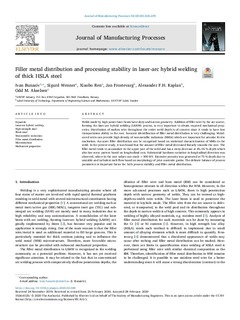| dc.contributor.author | Bunaziv, Ivan | |
| dc.contributor.author | Wenner, Sigurd | |
| dc.contributor.author | Ren, Xiaobo | |
| dc.contributor.author | Frostevarg, Jan | |
| dc.contributor.author | Kaplan, Alexander F.H. | |
| dc.contributor.author | Akselsen, Odd Magne | |
| dc.date.accessioned | 2020-03-17T09:00:18Z | |
| dc.date.available | 2020-03-17T09:00:18Z | |
| dc.date.created | 2020-03-16T10:30:23Z | |
| dc.date.issued | 2020 | |
| dc.identifier.citation | Journal of Manufacturing Processes. 2020, 54 228-239. | nb_NO |
| dc.identifier.issn | 1526-6125 | |
| dc.identifier.uri | http://hdl.handle.net/11250/2647099 | |
| dc.description.abstract | Welds made by high power laser beam have deep and narrow geometry. Addition offiller wire by the arc source,forming the laser-arc hybrid welding (LAHW) process, is very important to obtain required mechanical prop-erties. Distribution of molten wire throughout the entire weld depth is of concern since it tends to have lowtransportation ability to the root. Accurate identification offiller metal distribution is very challenging. Metal-cored wires can provide high density of non-metallic inclusions (NMIs) which are important for acicular ferritenucleation. Accuratefiller distribution can be recognized based on statistical characterization of NMIs in theweld. In the present study, it was found that the amount offiller metal decreased linearly towards the root. Thefiller metal tends to accumulate in the upper part of the weld and has a steep decrease at 45–55 % depth whichalso has wavy pattern based on longitudinal cuts. Substantial hardness variation in longitudinal direction wasobserved, where in the root values can reach > 300 HV. Excessive porosity was generated at 75 % depth due tounstable and turbulent meltflow based on morphology of prior austenite grains. The delicate balance of processparameters is important factor for both process stability andfiller metal distribution | nb_NO |
| dc.language.iso | eng | nb_NO |
| dc.publisher | Elsevier | nb_NO |
| dc.rights | Navngivelse 4.0 Internasjonal | * |
| dc.rights.uri | http://creativecommons.org/licenses/by/4.0/deed.no | * |
| dc.title | Filler metal distribution and processing stability in laser-arc hybrid welding of thick HSLA steel | nb_NO |
| dc.type | Journal article | nb_NO |
| dc.type | Peer reviewed | nb_NO |
| dc.description.version | publishedVersion | nb_NO |
| dc.source.pagenumber | 228-239 | nb_NO |
| dc.source.volume | 54 | nb_NO |
| dc.source.journal | Journal of Manufacturing Processes | nb_NO |
| dc.identifier.doi | 10.1016/j.jmapro.2020.02.048 | |
| dc.identifier.cristin | 1801786 | |
| dc.description.localcode | © 2020 The Author(s). Published by Elsevier Ltd on behalf of The Society of Manufacturing Engineers. This is an open access article under the CC BY license (http://creativecommons.org/licenses/BY/4.0/). | nb_NO |
| cristin.unitcode | 194,66,20,0 | |
| cristin.unitname | Institutt for fysikk | |
| cristin.ispublished | true | |
| cristin.fulltext | original | |
| cristin.qualitycode | 1 | |

